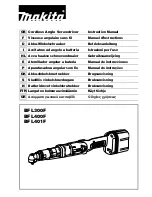
7
Adjusting the fastening torque
When you wish to drive machine screws, wood screws,
hex bolts, etc. with the predetermined torque, adjust the
fastening torque as follows.
1. First remove the battery cartridge from the tool.
2. Loosen and remove the screw that secures ring.
(Fig. 5)
3. Rotate the ring in the front of the tool by hand so that a
hole can be seen below the ring.
(Fig. 6)
4. Place the battery cartridge in place and pull the switch
trigger. Release it so that the adjusting ring rotates
and becomes visible in the hole. And then remove the
battery cartridge.
5. Use an optional adjusting grip to adjust the fastening
torque. Insert the pin of the adjusting grip into the hole
in the front of the tool. And then, turn the adjusting grip
clockwise to set a greater fastening torque, and coun-
terclockwise to set a smaller fastening torque.
(Fig. 7)
6. Align the edge of the adjusting ring with your desired
number on the fastening torque scale.
7. Insert the battery cartridge and be sure that a fasten-
ing torque has been set up by using a fastening torque
tester.
8. Rotate the ring in front of the tool and then tighten the
screw to secure the ring.
NOTE:
• Numbers on the fastening torque scale is a guideline to
set up your desired fastening torque.
ASSEMBLY
CAUTION:
• Always be sure that the tool is switched off and the bat-
tery cartridge is removed before carrying out any work
on the tool.
Selecting correct socket
There are different types of sockets for some models
depending on applications. Choose and install a correct
socket for your application.
Installing or removing socket (Fig. 8)
To install the socket, push it onto the square drive of the
tool with one hand by depressing a pin on the square
drive with another hand until it locks into place. To
remove the socket, simply pull it off depressing the pin on
the square drive.
OPERATION
Hold the tool firmly and place the socket over the bolt or
nut. Then switch the tool on. When the clutch cuts in, the
motor will stop automatically. Then release the switch
trigger.
NOTE:
• Hold the tool with its square drive pointed straight at the
bolt or nut, or the bolt or nut will be damaged.
Limits of fastening capacity (Fig. 9, 10, 11 & 12)
Use the tool within the limits of fastening capacity. If you
use the tool beyond the limits, the clutch does not work.
And the tool cannot deliver enough fastening torque.
NOTE:
• The revolution angle means the angle which a screw/
bolt revolves when the tool attains to 100% from 50% of
desired torque.
• Use of a low temperature conditioned battery cartridge
may sometimes give warning for battery cartridge
capacity by warning lamp and beeper which makes the
tool stop immediately. In this case, the range of fasten-
ing capacity may be inferior to those shown in the Fig.
9, 10, 11 and 12 even if a charged battery cartridge is
used.
MAINTENANCE
CAUTION:
• Always be sure that the tool is switched off and the bat-
tery cartridge is removed before attempting to perform
inspection or maintenance.
To maintain product SAFETY and RELIABILITY, repairs,
any other maintenance or adjustment should be per-
formed by Makita Authorized Service Centres, always
using Makita replacement parts.
ACCESSORIES
CAUTION:
• These accessories or attachments are recommended
for use with your Makita tool specified in this manual.
The use of any other accessories or attachments might
present a risk of injury to persons. Only use accessory
or attachment for its stated purpose.
If you need any assistance for more details regarding
these accessories, ask your local Makita service center.
• Protector (Yellow, Blue, Red, Clear)
• Various type of Makita genuine batteries and chargers
• Automatic refreshing adapter
• Adjust grip
• Switch lever set
• Spindle complete 12.7
ENG104-1
For European countries only
Noise
The typical A-weighted noise level determined according
to EN60745:
For Model BFL300F
Sound pressure level (
L
pA
): 72 dB (A)
Uncertainty (K): 3 dB (A)
The noise level under working may exceed 80 dB (A).
For Model BFL400F, BFL401F
Sound pressure level (
L
pA
): 73 dB (A)
Uncertainty (K): 3 dB (A)
The noise level under working may exceed 80 dB (A).
Wear ear protection.
ENG204-2
Vibration
The vibration total value (tri-axial vector sum) determined
according to EN60745:
For Model BFL300F
Work mode: screwdriving without impact
Vibration emission (
a
h
): 2.5 m/s
2
or less
Uncertainty (K): 1.5 m/s
2
For Model BFL400F, BFL401F
Work mode: screwdriving without impact
Vibration emission (
a
h
): 2.5 m/s
2
or less
Uncertainty (K): 1.5 m/s
2








































